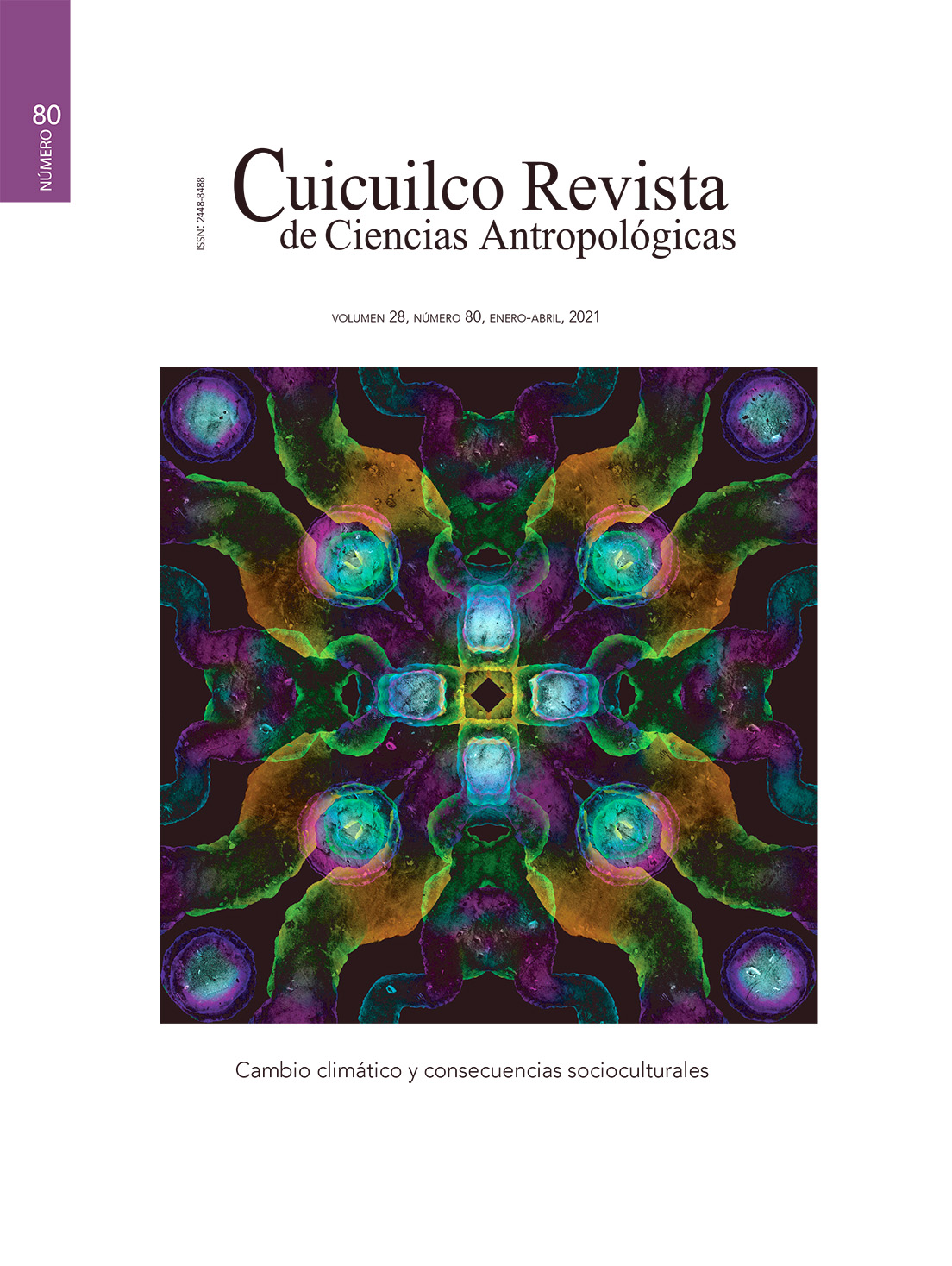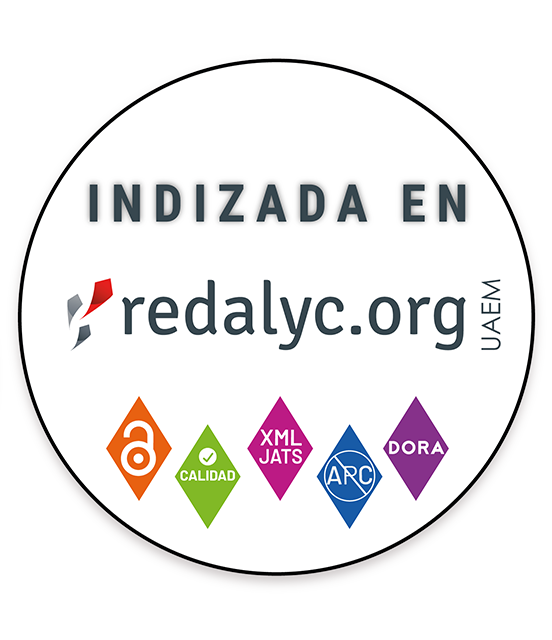Los episodios climáticos y las reorganizaciones culturales. Una mirada al Holoceno
Palabras clave:
Episodios climáticos, cambio climático, colapso, interacción, HolocenoResumen
El clima y el desarrollo de hombre han tenido una historia entreverada. A veces se le ha visto de forma determinista y otras con un ecologismo ingenuo. Estas reflexiones son importantes para entender el papel que ha jugado la humanidad en las modificaciones climáticas y la forma en que los cambios climáticos han impactado en la evolución humana. La revisión diacrónica del desarrollo del clima en el Holoceno muestra una gran cantidad de variables que inciden en sus alteraciones de corto y largo plazo. Por su parte, el ser humano ha actuado sobre entornos ambientales y ecológicos provocando extinciones masivas de especies. Esto expresa que la interacción entre sociedad y clima es de tipo complejo y no lineal y el impacto mutuo se ha dado en espacios de fragilidad. El Holoceno es un periodo de alta temperatura con abruptos episodios fríos. La tendencia parece indicar que óptimos climáticos han sido cálidos y han permitido el desarrollo y complejización de las sociedades, y que las crisis y colapsos se asocian con los abruptos episodios fríos y se relacionan con las transiciones al feudalismo y al capitalismo.
Descargas
Citas
Aberth, John. 2005, The Black Death: The Great Mortality Of 1348-1350: A Brief History With Documents. Bedford Series in History and Culture. Boston.
Ahmed, Moinuddin, Kevin J. Anchukyitis, Asrat Asfawossen et al. 2013, Continental-scale temperature variability during the past two millennia. Nature Geoscience, 6 (5): 339–346.
Anderson, Atholl. 1984, The Extinction of Moain Southern New Zealand, en Quaternary extinctions: a prehistoric revolution, Paul S. Martin y Richard. G. Klein (eds.). University of Arizona Press. Tucson: 728–740.
Armillas, Pedro. 1964, Condiciones ambientales y movimientos de pueblos en la frontera septentrional de Mesoamérica, en Homenaje a Fernando Márquez-Miranda, arqueólogo e historiador de América. Seminario de Estudios Americanistas y Seminario de Antropología Americana (ed.), Universidades de Sevilla y Madrid. Madrid: 62–82.
Bar-Yosef, Ofer, y Anna Belfer-Cohen. 1989, The origins of sedentism and farming communities in the Levant. Journal of world prehistory. 3(4): 447–498. 1992, From foraging to farming in the Mediterranean Levant. Transitions to agriculture in prehistory: 21–48.
Bartra, Roger. 1975, Ascenso y caída de Teotihuacan, en Marxismo y sociedades antiguas. El modo de producción asiático y el México prehispánico, Roger Bartra (ed.). Editorial Grijalbo. México: 99–118. 1992, El salvaje en el espejo. ERA/UNAM. México.
Benz, B. F. 2001, Archaeological evidence of teosinte domestication from Guilá Naquitz, Oaxaca. Proceedings of the National Academy of Sciences of the United States of America, 98 (4): 2104–2106.
Berlin, Isaiah. 2019, El fuste torcido de la humanidad: Capítulos de historia de las ideas. Ediciones Península. Madrid.
Bernal, Ignacio. 1959, Evolución y alcance de las culturas mesoamericanas, en Esplendor del México Antiguo, Carmen Cook de Leonard (ed.). Centro de Investigaciones Antropológicas de México. México: 97–126.
Binford, Lewis R. 1965, Archaeological Systematics and the Study of Culture Process. American antiquity, 31 (2): 203.
Blümel, Wolf Dieter. 2009 Natural climatic variations in the Holocene: past impacts on cultural history, human welfare and crisis, en Facing Global Environmental Change. Environmental, Human, Energy, Food, Health and Water Security Concepts, Hans Gu?nter Brauch, Úrsula Oswald Spring, John Grin, et al. (eds.). Springer, Berlin, Heidelberg: 103–118.
Bond, Gerard. 1997, A Pervasive Millennial-Scale Cycle in North Atlantic Holocene and Glacial Climates. Science, 278 (5341): 1257–1266.
Büntgen, Ulf, Vladimir S. Myglan, Fredrik Charpentier Ljungqvist et al. 2016, Cooling and societal change during the Late Antique Little Ice Age from 536 to around 660 AD. Nature Geoscience, 9 (3): 231–236.
Büntgen, Ulf, Willy Tegel, Kurt Nicolussi et al. 2011, 2500 years of European climate variability and human susceptibility. Science, 331 (6017): 578–582.
Comisión Internacional de Estratigrafía (CIE). 2018, Tabla Cronoestratigráfica Internacional. http://www.stratigraphy.org/ICSchart/ChronostratChart2018-08Spanish.pdf Consultado el 11 de noviembre de 2019.
Cyphers, Ann. 2015, Las bellas teorías y los terribles hechos. Controversias sobre los olmecas del Preclásico inferior. Instituto de Investigaciones Antropológicas. México.
Dansgaard, W., J. W. C. White y S. J.Johnsen. 1989, The abrupt termination of the Younger Dryas climate event. Nature, 339 (6225): 532–534.
Darras, Véronique. 2006, Las relaciones entre Chupícuaro y el Centro de México durante el Preclásico reciente. Una crítica de las interpretaciones arqueológicas. Journal of Scientific Agriculture, 92 (92-1 y 2): 69–110.
Davis, Basil. A. S., Simon Brewer, Anthony Clark Stevenson et al. 2003, The temperature of Europe during the Holocene reconstructed from pollen data. Quaternary science reviews, 22 (15-17): 1701–1716.
Dean, Kytharine R., Fabienne Krauer, Lars Walloe et al. 2018, Human ectoparasites and the spread of plague in Europe during the Second Pandemic. Proceedings of the National Academy of Sciences of the United States of America, 115 (6): 1304–1309.
Diamond, Jared M. 1984, Historic Extinction: A Rosetta Stone for Understanding Prehistoric Extinctions, en Quaternary extinctions: a prehistoric revolution, Paul S. Martin y Richard G. Klein (eds.). University of Arizona Press. Tucson: 824–866. 2002, Archaeology: Life with the artificial Anasazi. Nature, 419 (6907): 567–569. 2005, Collapse: How societies choose to fail or succeed. Viking. Nueva York.
Dull, Robert A., John R. Southon, Steffen Kutterolf et al. 2019, Radiocarbon and geologic evidence reveal Ilopango volcano as source of the colossal ‘mystery’ eruption of 539/40 CE. Quaternary Science Reviews, 222: 105855.
Equihua Zamora, Miguel, Arturo Hernández Huerta, Octavio Pérez Maqueo et al. 2016, Cambio global: el Antropoceno. Ciencia Ergo Sum, 23, marzo-junio: 67–75. http://www.redalyc.org/jatsRepo/104/10444319008/index.html Consultado el 11 de noviembre de 2019.
Fagan, Brian. 2007, El largo verano. De la Era Glacial a nuestros días. Editorial Gedisa. Barcelona. 2008, La Pequeña Edad de Hielo. Cómo el clima afectó a la historia de Europa. 1300-1850. Gedisa. Barcelona.
Fernández López de Pablo, Javier y Michael A. Jochim. 2010, The Impact of the 8 200 cal bp Climatic Event on Human Mobility Strategies During the Iberian Late Mesolithic. Journal of Anthropological Research, 66 (1): 39.
Florescano, Enrique. 1986 a Origen y desarrollo de los problemas agrarios de México. 1500-1821. ERA-SEP. México. 1986 b Precios del maíz y Crisis agrícolas en México, 1708-1810. Era. México.
Garza Merodio, Gustavo Gerardo. 2015, Caracterización de la Pequeña Edad de Hielo en el México central a través de fuentes documentales. Investigaciones Geográficas, (85): 82-94. 2017, Variabilidad climática en México a través de fuentes documentales (siglos XVI al XIX) Instituto de Geografía. UNAM. México.
Gill, Richardson B. 2008, Las grandes sequías mayas. Agua, vida y muerte. FCE. México.
Glosario: Datos proxy-Definición s/f https://meteoglosario.aemet.es/es/termino/426_datos-proxy Consultado el 19 de noviembre de 2019.
Gould, Stephen Jay. 2010, La estructura de la teoría de la evolución. Tusquets. Barcelona.
Gumerman, George J. (ed.). 1988, The Anasazi in a changing environment. Cambridge University Press. Cambridge.
Harari, Yuval Noah. 2014, De animales a dioses. Breve historia de la humanidad. Editorial Debate, Penguin Random House Grupo Editorial España, Edición de Kindle. España.
Harshman, John, Edward L. Braun, Michael J. Braun et al. 2008, Phylogenomic evidence for multiple losses of flight in ratite birds. Proceedings of the National Academy of Sciences of the United States of America, 105 (36): 13462–13467.
Kevin, Johnston.1997, Ecología Agrícola Tropical y el Colapso Maya en x Simposio de Investigaciones Arqueológicas en Guatemala, 1996, Jean Pierre Laporte y H. Escobedo (eds.). Museo Nacional de Arqueología y Etnología. Guatemala: 512–523.
Instituto Geológico y Minero de España (ed.) 1988, Riesgos geológicos. Instituto Geológico y Minero de España. Madrid.
Lachniet, M. S., Y. Asmerom, J. P. Bernal et al. 2012, A 2 400 y. Mesoamerican rainfall reconstruction links climate and cultural change. Geology, 40 (3): 259–262. 2013, Orbital pacing and ocean circulation-induced collapses of the Mesoamerican monsoon over the past 22 000 y. Proceedings of the National Academy of Sciences of the United States of America, 110 (23), 9255–9260.
Lavigne, Franck, Jean-Philippe Degeai, Jean-Christophe Komorowski et al. 2013, Source of the great a.d. 1257 mystery eruption unveiled, Samalas volcano, Rinjani Volcanic Complex, Indonesia. Proceedings of the National Academy of Sciences of the United States of America, 110 (42): 16742–16747.
Leakey, Richard E. 1997, La Sexta Extinción. El futuro de la vida y de la humanidad. Tusquets. Barcelona.
López Aguilar, Fernando. 2005, Símbolos del tiempo. Inestabilidad y bifurcaciones en los pueblos de indios del Valle de Mezquital. Consejo Estatal para la Cultura y las Artes de Hidalgo. Pachuca. 2011, Archaological stratigraphy, discontinuities and evolution, en Darwin’s Evolving Legacy, Jorge Martínez Contreras y Aura Ponce de León (eds.). Siglo XXI Editores. Universidad Veracruzana. México: 359–366.
Lowe, Gareth W. 1998, Mesoamérica Olmeca: diez preguntas. INAH, Centro de Investigaciones Humanísticas de Mesoamérica, UNAM. México.
Lozano García, María Del Socorro, Priyadarsi Debajyoti Roy, Yohan Alexander Correa Metrio et al. 2015, Registros paleoclimáticos, en Reporte Mexicano de Cambio Climático. Grupo 1. Bases científicas. Modelos y modelización, 1, Benjamín Martínez López (coord.). UNAM/Programa de Investigación en Cambio Climático. México: 113–130.
Marcus, Joyce. 2001, La zona maya en el Clásico terminal, en Historia Antigua de México. El Horizonte Clásico, Linda Manzanilla y Leonardo López Luján (eds.). INAH-UNAM-Miguel Ángel Porrúa. México: 301–346.
Marina, José Antonio. 2010, Las culturas fracasadas. El talento y la estupidez de las sociedades. Editorial Anagrama. Barcelona.
Martin, Paul S. 1984, Prehistory Overkill: The Global Model, en Quaternary extinctions: a prehistoric revolution, Paul S. Martin y Richard. G. Klein (eds.). University of Arizona Press Tucson: 354–403.
Marx, Carlos. 1975, El Capital: Crítica de la economía Política, I. FCE. México.
Melville, Elinore G. K. 1994, A Plague of Sheep: Environmental Consequences of the Conquest of Mexico. Cambridge University Press. Cambridge.
Menéndez Fernández, Mario. 2013, Prehistoria reciente de la península ibérica. UNED. España.
National Centers for Environmental Information (NCEI) s/f What Are “Proxy” Data? Formerly known as National Climatic Data Center (NCDC). https://www.ncdc.noaa.gov/news/what-are-proxy-data Consultado el 20 de noviembre de 2019.
National Geographic. 2015, El volcán islandés que cambió el clima de Europa. October 15. https://historia.nationalgeographic.com.es/a/volcan-islandes-que-cambio-clima-europa_9672 Consultado el 18 de julio del 2020.
Ortega-Guerrero, Beatriz, Marco Albán Albarrán-Santos, Margarita Caballero et al. 2018, Reconstrucción paleoambiental de la subcuenca de Xochimilco, centro de México, entre 18 000 y 5 000 años antes del presente. Revista Mexicana de Ciencias Geológicas, 35 (3): 254–267.
Pages 2k Consortium. 2015, Erratum: Corrigendum: Continental-scale temperature variability during the past two millennia. Nature Geoscience, 8 (12): 981–982.
Parker, Geoffrey. 2013, El siglo maldito. Clima, guerras y catástrofes en el siglo XVII. Editorial Planeta. Barcelona.
Pauketat, Timothy R. 2004, Ancient Cahokia and the Mississippians. (Case Studies in Early Societies). Cambridge University Press. Cambridge.
Rasool, S. Ichitaque y Nicolas Skrotzky. 1989, La tierra, ese planeta diferente. Gedisa. Barcelona.
Reynoso, Carlos. 2006, Complejidad y caos: una exploración antropológica. Editorial SB. Buenos Aires.
Roberts, Neil y Arlene Rosen. 2009, Diversity and Complexity in Early Farming Communities of Southwest Asia: New Insights into the Economic and Environmental Basis of Neolithic Çatalhöyu?k. Current anthropology, 50 (3): 393–402.
Roffet-Salque, Mélanie, Arkadiusz Marciniak, Paul J. Valdes et al. 2018, Evidence for the impact of the 8.2-kyBP climate event on Near Eastern early farmers. Proceedings of the National Academy of Sciences of the United States of America, 115 (35): 8705–8709.
Rosenswig, Robert M., Brendan J. Culleton, Douglas J. Kennett et al. 2018, The early izapa kingdom: recent excavations, new dating and middle formative ceramic analyses. Ancient Mesoamerica, 29 (2): 373–393.
Rutgers University. 2006, Icelandic Volcano Caused Historic Famine In Egypt, Study Shows, 22 de noviembre. Rutgers, the State University of New Jersey. https://www.sciencedaily.com/releases/2006/11/061121232204.htm Consultado el 18 de Julio del 2020.
Sigl, Michael, Mai Winstrup, Joseph R. McConnell et al. 2015, Timing and climate forcing of volcanic eruptions for the past 2 500 years. Nature, 523 (7562): 543–549.
Sinha, Ashish, Gayatri Kathayat, Harvey Weiss et al. 2019, Role of climate in the rise and fall of the Neo-Assyrian Empire. Sci. Adv., 5 (11): eaax6656.
Sparks, R. J., W. H. Melhuish, J. W. A. McKee et al. 1995, 14C Calibration in the Southern Hemisphere and the Date of the Last Taupo Eruption: Evidence from Tree-Ring Sequences. Radiocarbon, 37 (2): 155–163.
Tainter, Joseph. 1995, The Collapse of Complex Societies. Cambridge University Press. Cambridge.
Taleb, Nassim. 2013, Antifrágil: las cosas que se benefician del desorden. Grupo Planeta (gbs). Barcelona.
Trotter, Michael M. y Beverley McCulloch. 1984, Moas, Men, and Middens, en Quaternary extinctions: a prehistoric revolution, Paul S. Martin y Richard. G. Klein (eds.). University of Arizona Press. Tucson: 708–727.
Wainwright, John y Gianna Ayala. 2019, Teleconnections and environmental determinism: Was there really a climate-driven collapse at Late Neolithic Çatalhöyu?k? Proceedings of the National Academy of Sciences of the United States of America, 116 (9): 3343–3344.
Willey, Gordon R. y Phillip Phillips. 1958, Method and Theory in American Archaeology. University of Chicago Press. Chicago.
Yu, Zicheng y Ulrich Eicher. 2004, Three amphi-Atlantic century-scale cold events during the Bølling-Allerød warm period. Géographie physique et Quaternaire, 55 (2): 171–179.
Zahler, Diane. 2009, The Black Death. Twentyfirst Century Books. Minneapolis.
Ziegler, Philip. 2009, Black Death. Harper Collins Publishers. Nueva York.
Publicado
Versiones
- 2022-02-13 (2)
- 2021-06-20 (1)







